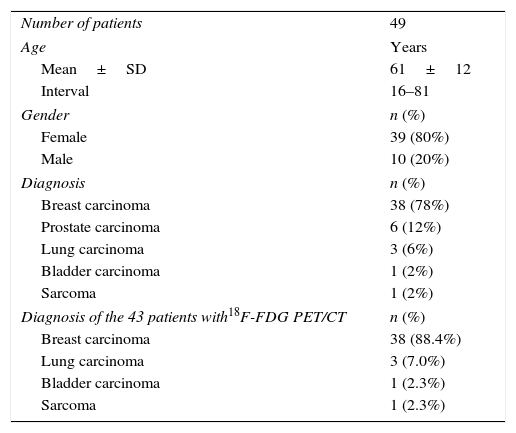To evaluate the ability of SUVmax to differentiate bone metastases from degenerative lesions, blastic from lytic metastases, as well as to determine the correlation between SUVmax with 18F-NaF and with 18F-FDG.
Material and methodsA review was performed on 115 18F-NaF PET/CT studies. Of the 64 patients with bone metastases, 49 (39 women, 10 men, 61±12 years (16–81)), in whom the PET/CT supported the diagnosis of bone metastases, were selected for analysis. A record was made of the SUVmax of a maximum of ten metastases in each patient (total 172: 141 blastic, 31 lytic), as well as four degenerative lesions (total 188) with the greatest 18F-NaF uptake intensity. Of the 49 patients analyzed, 43 also had a 18F-FDG PET/CT performed in which a record was made of the SUVmax values for 18F-FDG calculated in the locations corresponding to the bone metastases observed in the 18F-NaF PET/CT: 128 metastases (106 blastic, 22 lytic).
ResultsThe mean of the SUVmax values was significantly higher in metastases than in degenerative lesions, 26.8±17.3 vs. 15.3±6.3 (P<0.001) and in blastic than in lytic metastases, 27.9±18.3 vs. 22.1±11.3 (P=0.03). A SUVmax value above 42 always represented metastases, with all values above 49 representing blastic metastases. Using the SUVmax values, it was possible to predict the occurrence of metastases (AUC=0.723; P<0.001; 95% CI=0.671–0.776). The mean of the SUVmax with 18F-NaF was significantly higher in blastic metastases (27.9±18.3 vs. 22.1±11.3, P=0.03), whereas with 18F-FDG it was significantly higher in lytic ones (3.9±3.4 vs. 9.6±3.3; P<0.01).
ConclusionsSUVmax can contribute to the differentiation of metastases from degenerative lesions, and blastic from lytic metastases.
Evaluar la capacidad del SUVmax para diferenciar metástasis óseas de lesiones degenerativas, metástasis blásticas de líticas, así como la relación del SUVmax con 18F-FNa y con 18F-FDG.
Material y métodosRevisamos 115 exploraciones de PET/TC con 18F-FNa. De 64 pacientes con metástasis óseas, se seleccionaron 49 en los que la TC de la PET/TC apoyaba el diagnóstico de metástasis óseas: 39 mujeres y 10 hombres, 61±12 años (16-81). En cada paciente se calculó el SUVmax en un máximo de 10 metástasis (total 172: 141 blásticas, 31 líticas) y 4 lesiones degenerativas (total 188) que presentaban la mayor captación de 18F-FNa. De los 49 pacientes analizados, en 43 también se había realizado una exploración PET/TC con 18F-FDG y se calculó el valor de SUVmax para la 18F-FDG en las localizaciones correspondientes a las metástasis óseas observadas en la PET/TC con 18F-FNa: 128 metástasis (106 blásticas, 22 líticas).
ResultadosEl SUVmax promedio fue más elevado en las metástasis que en las lesiones degenerativas, 26,8±17,3 vs. 15,3±6,3 (p<0,001), y más elevado también en las metástasis blásticas que en las líticas: 27,9±18,3 vs. 22,1±11,3 (p=0,03). Todas las metástasis presentaron un valor de SUVmax>42 y las blásticas>49. La utilización del SUVmax permitió predecir la presencia de metástasis (AUC=0,723; p<0,001; IC95%=0,671-0,776). El valor medio de SUVmax con 18F-FNa fue significativamente más alto en las metástasis blásticas (27,9±18,3 vs. 22,1±11,3; p=0,03), mientras que el de 18F-FDG fue significativamente más alto en las líticas (3,9±3,4 vs. 9,6±3,3; p<0,01).
ConclusionesEl SUVmax puede ayudar a diferenciar metástasis de lesiones degenerativas y metástasis blásticas de líticas.
Artículo

Revista Española de Medicina Nuclear e Imagen Molecular (English Edition)












